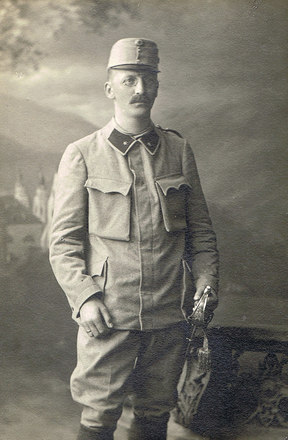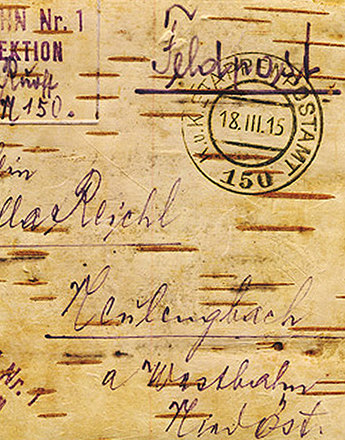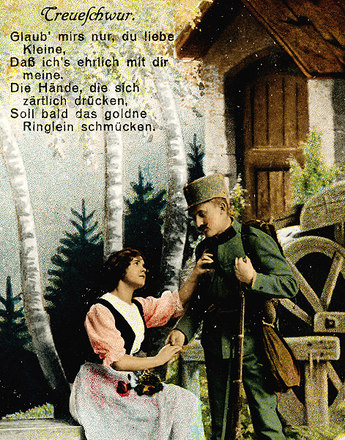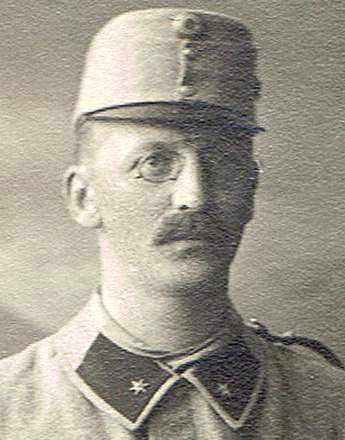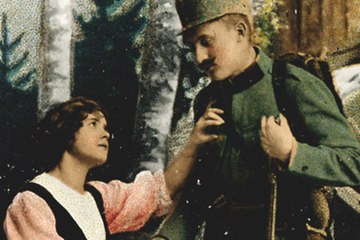Just three days after Austria’s declaration of war on Serbia on 1 August 1914, Ottokar Hanzel was drafted to Fortress Artillery Battalion No. 4, and from there to Reserve Company ‘Franzensfeste’ in Tyrol.
On 1 November 1914 he received his first promotion to senior Landsturm lieutenant, then exactly three years later to Landsturm captain. Ottokar Hanzel was also awarded several medals during the course of the war, including the bronze and silver medal for military merit.
During the four years of the war Ottokar Hanzel was commander of the artillery group Riva and Brione, commander of a field company and commandant of Fort Garda. Thus he was stationed exclusively in theatres of war on the Italian front, specifically at fortifications that had been built during the nineteenth century for defence purposes.
That Ottokar Hanzel carried out his duties as an officer during the four years of war not only conscientiously but with zeal is attested by his army dossier. In this he is described as ‘undaunted, cool-headed and courageous (...), an open, steadfast, conscientious character, of serious disposition, calm temperament. (...), very zealous, with very good results, (...) an excellent influence on his subordinates; both on officers and men’.
Shortly after the war began the Hanzels started to number their letters and continued to do so for the entire period of their correspondence. Thus in one of the first surviving letters from Ottokar Hanzel to his wife, dated 3 August 1914, he writes: ‘From now on I shall number each message to you, so [this is] No.3. Do the same, and confirm that you have received this letter.’
Since the numeration began afresh each time Ottokar Hanzel had returned from home leave, it has been possible, as historians Bernold and Gehmacher have pointed out, to establish that there were eight periods of separation. The two longest periods took place in 1915 and 1916 and lasted nine and ten-and-a-half months respectively. As a rule, however, Hanzel could go on home leave after a little more than six months for a maximum of two weeks; in the spring of 1918 the family saw each other at even shorter intervals.
In addition to the numbering the couple informed each other of the receipt of letters and postcards in brief notes, such as for example: ‘Vienna, 3 Oct. 1917. No. 29 dated 1/10 received’. Many of their communications were marked after the event with the number of the letter and the date of receipt. Mathilde Hanzel also noted the numbers of the letters received and sent in one of her diaries, thus recording the time taken by a letter from the front line to Vienna and vice versa. This reveals that the service was very variable, and a letter or postcard could take anything from two or three to more than ten days to reach its destination. Thus the receipt and sending of post as well as the act of writing in itself were constantly recurring topics from the very beginning of their correspondence.
Translation: Sophie Kidd
Bernold, Monika/Gehmacher, Johanna: Auto/Biographie und Frauenfrage. Tagebücher, Briefwechsel, Politische Schriften von Mathilde Hanzel-Hübner (1884-1970), Wien 2003
Rebhan-Glück, Ines: „Wenn wir nur glücklich wieder beisammen wären …“ Der Krieg, der Frieden und die Liebe am Beispiel der Feldpostkorrespondenz von Mathilde und Ottokar Hanzel (1917/18), Unveröffentlichte Diplomarbeit, Wien 2010
Rebhan-Glück, Ines: Liebe in Zeiten des Krieges. Die Feldpostkorrespondenz eines Wiener Ehepaares (1917/18), in: ÖGL (2012), 56/3, 231–246
Quotes:
„‘undaunted, cool-headed and courageous ...“: Qualifikationsliste, Österreichisches Staatsarchiv, Abteilung Kriegsarchiv, Personalakten, Pers. Quall: Grundbuchblatt und Qualifikationsliste Ottokar Hanzel. Karton: HANUSZ-HAQUI 961, Bogen 6 (Translation: Sophie Kidd)
„an open, steadfast, conscientious …“: Qualifikationsliste: Österreichisches Staatsarchiv, Abteilung Kriegsarchiv, Personalakten, Pers. Quall: Grundbuchblatt und Qualifikationsliste Ottokar Hanzel. Karton: HANUSZ-HAQUI 961, Bogen 4 (Translation. Sophie Kidd)
„an excellent influence on …“: Qualifikationsliste: Österreichisches Staatsarchiv, Abteilung Kriegsarchiv, Personalakten, Pers. Quall: Grundbuchblatt und Qualifikationsliste Ottokar Hanzel. Karton: HANUSZ-HAQUI 961, Bogen 5 (Translation: Sophie Kidd)
„From now on I shall number ...“: Ottokar Hanzel to Mathilde Hanzel, 03.08.1914, Sammlung Frauennachlässe, Nachlass 1, Institut für Geschichte der Universität Wien (Translation: Sophie Kidd)
„Vienna, 3 Oct. 1917. No. 29 ...“: Mathilde Hanzel to Ottokar Hanzel, 03.10.1917, Sammlung Frauennachlässe, Nachlass 1, Institut für Geschichte der Universität Wien (Translation: Sophie Kidd)
„Since the numeration began afresh each time …“: Bernold, Monika/Gehmacher, Johanna: Auto/Biographie und Frauenfrage. Tagebücher, Briefwechsel, Politische Schriften von Mathilde Hanzel-Hübner (1884-1970), Wien 2003, CD-ROM, 205
„The two longest periods …”: Bernold, Monika/Gehmacher, Johanna: Auto/Biographie und Frauenfrage. Tagebücher, Briefwechsel, Politische Schriften von Mathilde Hanzel-Hübner (1884-1970), Wien 2003, CD-ROM, 205
„Mathilde Hanzel also noted the numbers …”: Bernold, Monika/Gehmacher, Johanna: Auto/Biographie und Frauenfrage. Tagebücher, Briefwechsel, Politische Schriften von Mathilde Hanzel-Hübner (1884-1970), Wien 2003, CD-ROM, 205
-
Chapters
- How does a collection of letters come to be stored in an archive?
- The protagonists: Mathilde Hübner and Ottokar Hanzel
- Love, marriage, career
- The separation begins
- ‘War fever’ versus the longing for peace
- Italy’s ‘betrayal’ in 1915
- ‘… surely this war must end some time?!’
- ‘… and tomorrow we will start cheerily canvassing for peace.’
- Black marketeering, profiteering and self-subsistence
- A love affair in wartime

